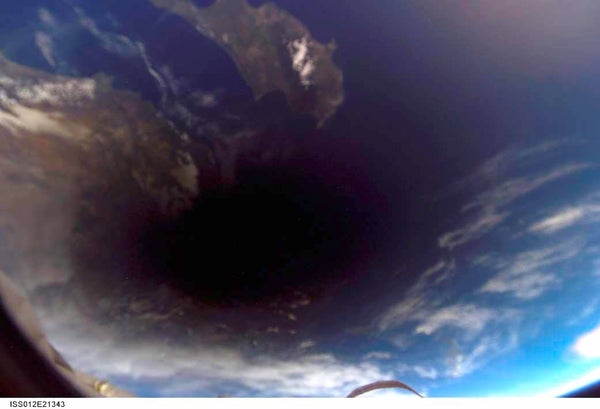This article was published in Scientific American’s former blog network and reflects the views of the author, not necessarily those of Scientific American
In recent days I’ve been reading a few eye-witness accounts of total solar eclipses across the ages. What’s common to almost all of these descriptions is the genuine sense of awe that a blocked-out sun evokes. That awe come from different pieces of the experience. It’s in the alien vista of the Sun’s corona, or in the spectacle of Bailey’s beads, or the sudden chill that descends on an otherwise warm sunny day and the wind that whips up.
But what’s bothered me is why some of these phenomena should have such a visceral impact. After all, a stray cloud can do a pretty good job at blotting the Sun out, as can a well-placed umbrella or hand.
And that got me interested in the actual dimensions of the shadow cast by the Moon. This shadow is really divided into three zones, depending on the eclipse configuration. The inner umbra of total eclipse, the outer penumbra of partial eclipse, and the antumbra between these two if the moon’s distance allows an annular eclipse – the Sun peeking around the lunar disk.
On supporting science journalism
If you're enjoying this article, consider supporting our award-winning journalism by subscribing. By purchasing a subscription you are helping to ensure the future of impactful stories about the discoveries and ideas shaping our world today.
The umbra is the money shot. For an eclipse crossing the Earth’s equator, with the Moon at its closest to us, the scale of the umbra is roughly 150 kilometers across. If the shadow intersects the planet at higher latitudes the umbra can stretch out to perhaps 1,000 kilometers due to the shallower angle of the light rays from the Sun. The larger the umbra, the longer the total eclipse for an observer.
But if the Moon is at its furthest the umbra can disappear, leaving just an antumbra, or a very brief umbra. For example, in December of 2067 a solar eclipse will take place with a small umbra, giving a viewer a mere 8 seconds to enjoy totality. By comparison, on August 21st 2017 the North American eclipse will have an umbra spanning roughly 115 kilometers, and at best a 2 minute totality for the luckily positioned.
All of which gets me back to the shock-and-awe piece of a total eclipse. If you stand outside on a non-mountainous part of the planet, the visible horizon is only about 5 kilometers around the Earth’s curved surface from your location. Climb up a hill of about 100 feet and you can see a bit further – to perhaps 20 kilometers.
So, if you’re in the middle of an eclipse umbra spanning 100 to 150 kilometers, absolutely everything within your horizon, and quite a bit more, will be simultaneously shaded from the Sun. That is simply a phenomenon that does not happen in any other situation, ever. The light scattering in the atmosphere above your location will change, as will reflected and scattered surface light from further than your visible horizon.
It’s perhaps not surprising that a total eclipse of the Sun speaks to us so profoundly.
